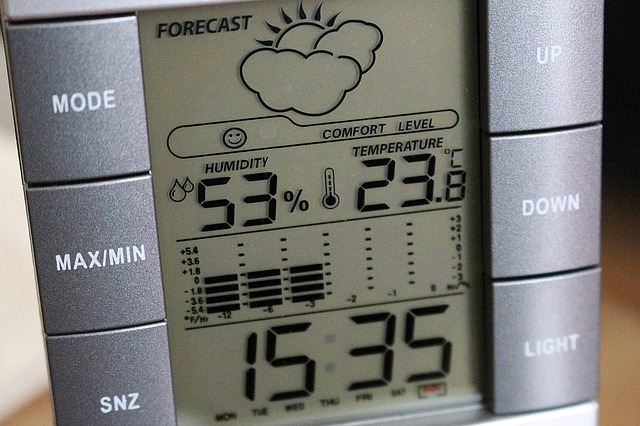Humidity
Air will generally include moisture in the form of water vapour. Absolute humidity is the mass of water vapour in a volume of air divided by the mass of dry air.
Relative humidity (RH) is a measure of the water vapour density of air compared to the water vapour density for saturated air at the same temperature and pressure (that is, the maximum amount of moisture that air can 'hold' at that temperature and pressure). It is expressed as a percentage.
RH = (actual water vapour density / saturation water vapour density) x 100
When air cools, it is less able to “hold” moisture, that is, the saturation water vapour density falls, and so relative humidity rises. When the relative humidity reaches 100%, the air will be saturated. This is described as the dew point. If the air continues to cool, moisture will begin to condense.
Humidity influences thermal comfort. The higher the relative humidity, the less heat a person is able to lose through the evaporation of moisture on the skin, and so the hotter they will feel. Conversely, air that is too dry can cause problems such as dry eyes, nose, ears and throat. Typically, a relative humidity of 40 to 60% is appropriate in many buildings.
Humidity also affects the performance of buildings, causing condensation, mould growth, mildew, staining, slip hazards, damage to equipment and the corrosion and decay of the building fabric as well as poor performance of insulation. Condensation can occur on surfaces, or can be interstitial condensation, occurring between the layers of the building envelope, typically as a result of air diffusing from the warm interior of the building to the cool exterior and reaching its dew point within the building fabric.
Humidity can be measured using a hygrometer. Typically these are electronic moisture detectors, or devices such as a sling psychrometer which measures dry-bulb temperature and wet-bulb temperature, allowing relative humidity to be calculated or read from charts.
Humidity can be controlled by limiting sources of moisture (including reverse condensation, where moisture evaporates from damp materials), increasing temperatures, humidification or dehumidification, and by ventilation. Condensation can be further avoided by increasing surface temperatures (such as by the inclusion of insulation or by improving glazing).
In particular, it is necessary to avoid cold bridges, situations in a building where there is a direct connection between the inside and outside through one or more elements that are more thermally conductive than the rest of the building envelope, resulting in lower localised temperatures.
Humidity and condensation in buildings is regulated by Approved Document C (Site preparation and resistance to contaminates and moisture) and Approved Document F (Ventilation) and further guidance is available in BS 5250 Code of practice for the control of condensation in buildings.
NB Illustrated Guide to Mechanical Cooling (BG 1/2010), written by Kevin Pennycook and published by BSRIA in 2010, defines Relative humidity as: ‘A term often used to specify the internal design condition for humidity within a space. A ratio, usually expressed as a percentage, indicating the humidity of the air. Literally the actual vapour pressure of the air at a given dry bulb temperature divided by the saturation vapour pressure of the air at the same temperature.’
[edit] Related articles on Designing Buildings
- Air conditioning.
- Approved Document F.
- Condensation.
- Damp proofing.
- Dehumidification.
- Designing HVAC to resist harmful microorganisms.
- Dew point.
- Diagnosing the causes of dampness (GR 5 revised).
- Dry-bulb temperature.
- Humidification.
- Humidistat.
- HVAC.
- Interstitial condensation.
- Methodology for moisture investigations in traditional buildings.
- Moisture.
- Moisture content.
- Mould growth.
- Psychometric chart.
- Rising damp.
- Sling psychrometer.
- Thermal comfort.
- Thermal indices.
- Water vapour.
- Wet-bulb temperature.
Featured articles and news
RTPI leader to become new CIOB Chief Executive Officer
Dr Victoria Hills MRTPI, FICE to take over after Caroline Gumble’s departure.
Social and affordable housing, a long term plan for delivery
The “Delivering a Decade of Renewal for Social and Affordable Housing” strategy sets out future path.
A change to adoptive architecture
Effects of global weather warming on architectural detailing, material choice and human interaction.
The proposed publicly owned and backed subsidiary of Homes England, to facilitate new homes.
How big is the problem and what can we do to mitigate the effects?
Overheating guidance and tools for building designers
A number of cool guides to help with the heat.
The UK's Modern Industrial Strategy: A 10 year plan
Previous consultation criticism, current key elements and general support with some persisting reservations.
Building Safety Regulator reforms
New roles, new staff and a new fast track service pave the way for a single construction regulator.
Architectural Technologist CPDs and Communications
CIAT CPD… and how you can do it!
Cooling centres and cool spaces
Managing extreme heat in cities by directing the public to places for heat stress relief and water sources.
Winter gardens: A brief history and warm variations
Extending the season with glass in different forms and terms.
Restoring Great Yarmouth's Winter Gardens
Transforming one of the least sustainable constructions imaginable.
Construction Skills Mission Board launch sector drive
Newly formed government and industry collaboration set strategy for recruiting an additional 100,000 construction workers a year.
New Architects Code comes into effect in September 2025
ARB Architects Code of Conduct and Practice available with ongoing consultation regarding guidance.
Welsh Skills Body (Medr) launches ambitious plan
The new skills body brings together funding and regulation of tertiary education and research for the devolved nation.
Paul Gandy FCIOB announced as next CIOB President
Former Tilbury Douglas CEO takes helm.
UK Infrastructure: A 10 Year Strategy. In brief with reactions
With the National Infrastructure and Service Transformation Authority (NISTA).























